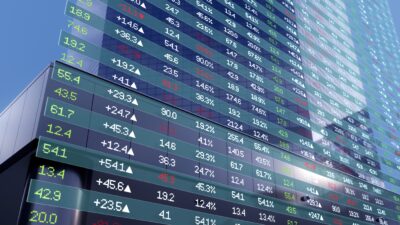ASX investors have been keeping a close eye on the government's spending plans.
And for good reason.
The Federal Budget is a doozy.
As the government continues to prioritise getting the economy up to full speed and standing on its own 2 legs, they've loosened the purse strings to the hilt.
This will see the budget deficit likely reach 7.8% of Australia's GDP, its highest share of GDP since the post-World War II rebuild efforts in 1946.
However, Shane Oliver, head of investment strategy and chief economist at AMP Capital, said the government's focus on growing the economy rather than staying within budget "is the right thing to do at present".
Oliver spearheaded AMP Capital's Webinar yesterday.
I covered off his overall take on the Federal Budget as well as his 5 essential tips for ASX investors in separate articles.
Here, we'll focus on the budget's likely impact on the ASX, as well as Australia's red-hot residential property market.
How the Federal Budget will impact the ASX
While cautioning about the likelihood of a short-term correction on the ASX (which may currently be underway), Oliver's mid-term outlook for the All Ordinaries Index (ASX: XAO) is decidedly bullish.
"One of the things the share market likes is more stimulus," he said. With plenty more stimulus contained in the Federal Budget, this will be good for earnings. Indeed, he expects to see "very strong earnings growth".
Oliver added the following words of caution:
Just allow that shares have had a very strong run up already this year, up until the record high a couple of days ago. At some point we're going to see a bit of a correction. Now they are normal. They make everyone nervous, but they are normal.
Despite forecasting a correction (generally defined as a pullback of more than 10% but less than 20%, which is labelled a 'crash'), Oliver is bullish on his outlook for the overall performance of the ASX this year. "I reckon shares will end the year higher than they are presently," he said.
Positive factors he listed that will support the ASX performance over the medium term include: the rollout of effective coronavirus vaccines; the reopening of developed nations; a falling US dollar, the safe-haven currency, which is normally positive for shares; and easy fiscal and monetary policy continuing, with stimulus still working its way through the economy.
ASX dividend shares were also on his radar.
According to Oliver, "The dividend yield on shares, which was cut last year, is now on the way back up again."
AMP forecasts grossed-up yields, taking franking credits into account, of around 5% this year.
Comparing that to the 0.5% from bank deposits, Oliver said, "Obviously that creates a flow of money into share markets through time."
As for potential risks to the ASX performance, Oliver noted 3: China tensions spiralling; dangerous COVID variants; and an inflation spike.
Inflation is coming to the ASX but likely transitory
The key risk of the Federal Budget to ASX shares that Oliver pointed to was that it could push the Reserve Bank of Australia (RBA) to raise rates faster than the central bank has said it will.
The RBA remains adamant it will not move to raise before 2024. A date AMP Capital already believes is a bit optimistic.
"We're expecting them to raise rates in 2023," Oliver said. "Two years away, but a little earlier than the Reserve Bank is talking about. That's still a long way away. But all this extra stimulus could bring forth the timing of that a bit."
Not that you should expect any significant returns from your cash deposits anytime soon.
"If you're a bank depositor, you're still going to get really low rates for some time to come," Oliver said. He noted that even if the RBA does start raising rates, the increase will likely be fractional. First moving the cash rate from 0.10% to 0.25%, and then 0.50%.
"They're still going to be very low numbers. I don't think you're going to get a lot of relief as a bank investor or bank deposit investor."
Oliver is equally bearish on his outlook for the returns you're likely to get from long-term government bonds. "With bond yields at around 1.7%, you've got a lot of running yield. If bond yields rise over time as the global economy continues to recover, which will probably happen, then you get capital loss."
Even if inflation does come back stronger than the RBA forecasts, Oliver doesn't expect it will be sustained. Rather it's more the result of temporary distortions from post-pandemic lockdowns creating a bottleneck of supply due to lockdowns running into the resurgent demand. That and the big price slump from a year ago distorts the year-on-year price rise figures.
"There's a good probability that when companies see demand pick up they ramp up production again which pushes prices back down," he said. "And eventually the spending will rotate back to services and take the pressure off of goods."
The 40-year trend of declining inflation looks over
While Oliver doesn't believe the inflation pressures will be an issue for more than the next 12 months, he did say that we've probably seen the lowest point in interest rates and inflation, both of which were historically low for several years before the onset of the pandemic.
This will eventually impact ASX shares that are more dependent on earnings growth as well as property more dependent on rental growth, both of which have benefited for years from falling rates. However, Oliver doesn't expect this to become an issue for the next year or so.
Higher debt levels for residential property
Moving away from the ASX, Oliver looked at the extra stimulus in the Federal Budget for residential property.
That includes "more assistance for homebuyers via deposit schemes with a Family Home Guarantee to help 10,000 single parents buy their own home with just a 2% deposit".
"I think it's great to help first-time buyers and single parents," Oliver said. "But if you make it easier for that group to get in without dramatically changing the supply and taking something away from other groups then you just end up with higher prices, and people getting in with very high debt levels."
Oliver noted that there were no forced sales during the downturn, "so with the reopening, prices took off".
He said, "Growth slowed a little in April but the residential property market is still very, very strong. You can see that in the auction clearance rates."
By 2023 AMP Capital forecasts that housing price growth may pause, or even "come down a bit". That's a factor of low population growth with a virtual halt to immigration along with an increasing number of unit completions.
"In the meantime, we're on a bit of a run," Oliver said. "I reckon this year we'll see [housing] price growth of 15%, and next year around 5%."









